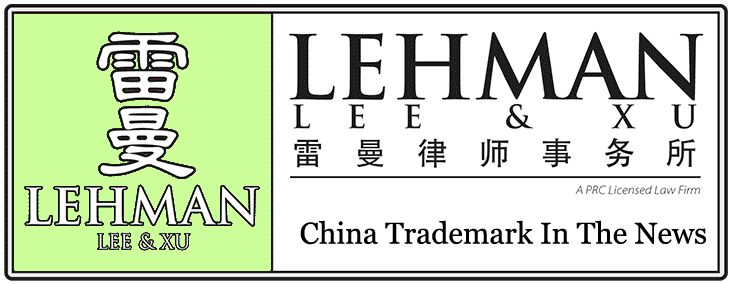I. Key Issues
With China’s rapid economic developments, the relevance of similar goods and services changes with the method of commercial trading, consumption habit, and consumer psychology. However, the Classification of Similar Goods and Services may not include all the goods and services, and there are often contradictions when determine whether goods and services are similar or not. There is a new trend that the Chinese Trademark Office (CTMO), the Trademark Review and Adjudication Board (TRAB), and the courts begin to grant cross-class protection by deeming goods and services similar.
In order to maintain the market order of fair competition and ensure the judicial ruling does not contradict with the public interests, it is necessary to break through the Classification of Similar Goods and Services on specific cases.
There are various reasons why cross-Class protection is granted by deeming goods and services similar: difficulties to recognize a trademark as well-known, cracking down bad faith filing, and in-depth understanding about the similarity of goods and services.
In general, the Classification of Similar Goods and Services should be complied with, and should not be easily break through, namely, breaking through the Classification of Similar Goods and Services should be applied stringently and conform to certain requirements and criterion.
II. Typical Cases
1. BAIDU
In this case, Beijing High Court (the second instance court) affirmed the decision of Beijing First Intermediate Court (the first instance court) where, according to the Classification of Similar Goods and Services, the infringing product falls under Class 9 while the trade mark “BAIDU in Chinese” (Registration No. 1579950) designated for “providing computer information via computer information network, etc.” fall under Class 42. The infringing products MP3 and MP4 media players (as a kind of equipment for downloading or storing audio and video) which are particularly associated with online audio and video searching services approved for the mark “BAIDU in Chinese.” Therefore, the use of the infringing products may cause confusion among the relevant public that there are particular association between the provider of the MP3 and MP4 media players and the online searching engine services provider.
2. ZHEN QIAO in Chinese and ZHENQIAO and Design
Beijing High Court (the second instance court) affirmed the decision of Beijing First Intermediate Court (the first instance court) where the goods designated under the disputed trademark “ZHEN QIAO in Chinese and ZHEN QIAO and Design” fall under Class 29, while the goods designated under the cited trademarks fall under Classes 29 and 30 respectively. The courts applied the factors as defined in Rule 11 of the Trademark Adjudication and Examination Standards to determine the similarity of the goods and found that the function, purpose, production department, sales channels, and target consumers of the two trademarks’ designated goods are closely related. Therefore, Beijing High Court affirmed that the goods under the two trademarks constitute identical or similar goods.
3. AI ER in Chinese
The opticians’ services designated under the disputed trademark “AI ER in Chinese” (Registration No. 4040366) and glasses and clinic services designated under the cited trademarks are not similar goods and services according to the Classification of Similar Goods and Services. However, the TRAB holds that optician’ services and glasses, clinic services are closely related in function, purpose, target customs, etc. Moreover, the cited marks enjoy high fame in the medical service industry. The coexistence of the disputed trademark and the cited trademark is very likely to cause confusion among the consumers. Therefore, the TRAB affirmed that the goods designated under the disputed trademark and those designated goods and services under the cited trademarks constitute similar goods/services.
4. banny OFFICE DEPOT
The TRAB holds that the goods “Copying paper [stationery]; Telex paper; etc” designated under the opposed mark and the goods “Stationery; Drawing board; etc” under the cited mark do not constitute similar goods according to the Classification of Similar Goods and Services. However, the court holds that the designated goods fall within the two marks are identical in sales channels, production department and target consumers, and are co-related in function.
Therefore, the designated goods under the opposed mark “banny OFFICE DEPOT” and those under the cited mark constitute similar goods.
III. Analysis and Comments
1. Laws and Regulations
(1) Article 30 of the Chinese Trademark Law 2013
Where a trademark registration has been applied for is not in conformity with the relevant provisions of this Law, or is identical with or similar to the trademark of another person that has, in respect of the same or similar goods, been registered or, after examination, preliminarily approved, the Trademark Office shall refuse the application and shall not publish the said trademark.
(2) Rules 11 and 12 of the Supreme People’s Court on Several Questions on the Application of Law in Trial of Trademark Civil Dispute Cases Interpretation
Rule 11: The similar goods under Article 52 (1) of the Chinese Trademark Law shall refer to goods with identical function, use, manufacturer, sales channel and target consumers or goods that the relevant public generally think related in a particular way or if is likely to cause confusion.
The similar service shall refer to service with identical purpose, content, mode or object or service with identical objective, content, mode and target consumers, or service that is likely to cause confusion.
The similarity of goods and service means that the goods or service is related to one another in a particular manner, or are likely to cause confusion on the part of the relevant public.
Rule 12: The people’s court shall establish whether or not a goods or service is similar according to the provision of Article 52 (1) of the Chinese Trademark Law in the light of the comprehensive assessment based on the average perception by the relevant public of the goods or service. The International Classification of Goods and Services for the Purpose of trademark Registration and the Classification for the Purpose of Distinguishing Similar Goods and Services may serve as the frame of reference for establishing similar goods or services.
In addition, Rule 12 prescribed that deem the goods or services similar should consider comprehensively the relevant public’ general understanding; and the Classification of Similar Goods and Services can serve as reference.
(3)Relevant Rules
“By Deeming Similar Goods” Section of Trademark Examination Standard, similar goods shall refer to goods are identical or similar in function, purpose, main material, manufacturing department, sales channel, sales place and target consumers, etc.
“By Deeming Similar Services” Section of Trademark Examination Standard, similar services shall refer to services are identical or similar in the purpose, content, mode and places, target customs, etc.
2. Requirements and principle for breaking through Classification of Similar Goods and Services
According to the trial practices of trademark administrative proceedings (TRAB as the defendant), the court and the TRAB’s disagreement in deeming goods/services similar or not is one of the main reasons the TARB lose, and the rate of the TRAB’s losing reaches 17% (2011), 24% (2012) and 22% (2013). In most of these cases, the TRAB strictly in according with the Classification of Similar Goods and Services in deciding goods/services do not constitute similar, while the court breaking the Classification of Similar Goods and Services and deeming the goods/services similar. In the meantime, the TRAB decided that goods/services constitute similar in consideration of the bad faith, relevance and the fame or distinctiveness of the cited mark, while the court affirmed otherwise.
The Classification of Similar Goods and Services is the principle for the CTMO, the TRAB, and courts to decide whether the goods and services are similar or not. Thus, this Classification shall not be breaking through easily, or it may cause disorder in deciding goods/services similar and even breaking the legislative balance between Article 13 (well-known trademark protection) and Article 30 of the China Trademark Law. Therefore, it must satisfy the following requirements and criterion when considering break through the Classification of Similar Goods and Services in case-by-case specific case. Otherwise, it may disturb the trademark management order and will damage the interest of the trademark holders.
(1) Requirement
A. The possibility of similarity between the disputed mark and the cited mark is relatively high;
B. The cited mark is inherently distinctive and bears originality.
C. The designated goods and services under the disputed mark and those under the cited mark are closely related.
D. The applicant is in apparent bad faith.
E. The cited mark enjoys certain fame.
F. The registration and use of the disputed mark is very likely to cause confusion among the relevant public.
The purpose of breaking through the Classification of Similar Goods and Services is to prevent and punish those bad faith application, thus, among the above 6 requirements, items C and D are the most critical factors. Thus, if one claims two trademarks should be deemed similar, he should focus on collecting evidence regarding the fame of prior trademark, the bad faith of the adversary, and the relatedness of goods and services.
(2) Principle
Based on the TRAB review and adjudication precedents, there are also criterions to be complied with:
A. In conformity with the Classification of Similar Goods and Services the specific case as the basis, breaking through the Classification only in specific case.
B. Protect the prior right and to avoid confusion among relevant public, comprehensive consideration of the specific facts of a case, the changing economic life of the goods and services, and various factors in determining the similarity of goods and services.
C. Clarify the boundaries between breaking Classification of Similar Goods and Services and the cross-protection granted by the well-known mark, specifically, the “breaking through” aims at granting cross-class protection in similar goods/services, the well-known trademark may obtain cross-class protection in “non similar” goods/services.
IV. Summary and Suggestion
Though there are great progress in the theory and practices of breaking through the Classification of Similar Goods and Services, it is important to note that the principle is strict application of the Classification of Similar Goods and Services. Breaking through should be applied as an exception. To maintain the trademark management order, the fair competition environment, and ensure the judicial ruling does not contradict with the public interests, when granting cross-Class protection by deeming goods and services similar, we shall:
1. Make sure to cite and focus on Article 30 of the Chinese Trademark Law 2013 in addition to well-known trademark provisions and bad faith filing provisions.
2. Satisfy the requirements and principle for breaking through the Classification of Similar Goods and Services.
http://www.beijingeastip.com/en/NewsShow.aspx?p=3&id=857dd04f-b11f-4631-a3e0-056f0e98b210&nid=c793ba7e-3b2e-4b5e-98cd-0f7a28469b5e#utm_source=Mondaq&utm_medium=syndication&utm_campaign=View-Original
|


